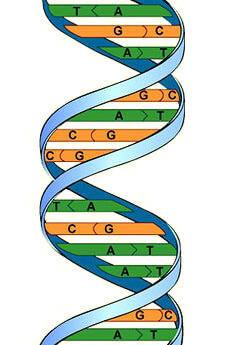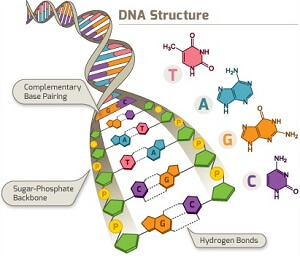The full form of DNA is Deoxyribonucleic Acid. DNA is the genetic material in all the eukaryotic organisms. DNA is present mostly in the nucleus of all cells and is a main component of chromosomes.
Chemical Composition of DNA
The basic structural unit of DNA is nucleotide i.e. DNA is made up of a large number of nucleotide molecules which are joined by covalent bonds to form a long chain. As the DNA is made up of a large number of nucleotide molecules so it is also called ‘polynucleotide’.

A nucleotide molecule is further made up of three different components:
1. A phosphate group
2. A pentose sugar
3. A nitrogen containing base
1. Phosphate group
The phosphate group present in DNA consists of 1 atom of phosphorous and 4 atoms of oxygen. While making the structure of DNA the phosphate group is represented by writing letter P in the circle as  .
.
2. Pentose sugar
The sugar present in DNA is a five carbon sugar or pentose sugar which is also called as deoxyribose sugar. In the structure of DNA the pentose sugar is represented by writing letter S in the pentagon as  .
.
3. Nitrogenous base
There are 4 different types of nitrogenous bases in the structure of DNA. The names of these 4 nitrogenous bases are
1. Adenine
2. Thymine
3. Cytosine and
4. Guanine.
These 4 nitrogenous bases are classified into two types:
1. Purines: – E.g. Adenine and Guanine.
2. Pyrimidines: – E.g. Cytosine and Thymine.
Structure of DNA

The structure of DNA was first of all established by two scientists named James Watson and Francis Crick in 1953. These scientists proposed that DNA molecule has a duplex structure i.e. DNA molecule consists of two strands of polynucleotide chains which are coiled around each other in the form of a double helix. That is why; it is also called as double helical structure of DNA. The single helical turn of DNA molecule has a breadth of 20 Ao length of 34 Ao in which 10 units of nucleotides are present. Each strand of DNA consists of alternating sugar and phosphate groups bonded with each other. The 4 nitrogenous bases i.e. adenine, cytosine, thymine and guanine are stacked inside the helix in planes perpendicular to the helical axis.
The nitrogenous base present on two opposite strands are bonded with each other with the help of weak hydrogen bonds. Adenine and Thymine are bonded by two hydrogen bonds whereas cytosine and guanine are bonded by three hydrogen bonds.
This structure of DNA resembles with the structure of a spiral staircase in which the steps are represented by nitrogenous bases and railing of the staircase is represented by the sugar phosphate framework.
Test Your Understanding and Answer These Questions:
- Write the full form of DNA.
- Why is DNA called a polynucleotide?
- Explain chemical composition of DNA.
- Name two purines and pyrimidines.
- What are the components of deoxyribo nucleic acid?
- How many types of nitrogenous bases are present in a molecule of DNA? Name them.
- Explain double helical structure of DNA proposed by Watson and Crick.
- What types of bonds are present between two polynucleotide strands of DNA?
